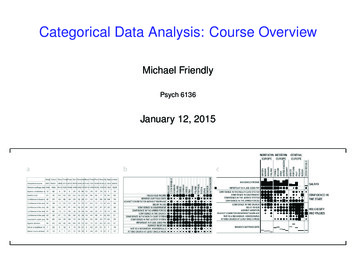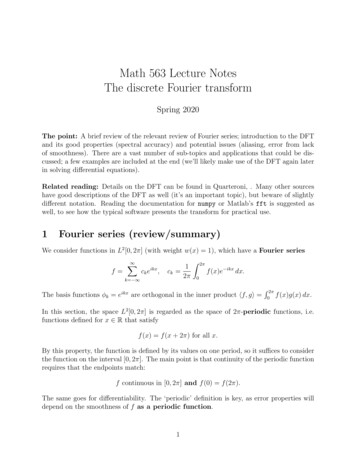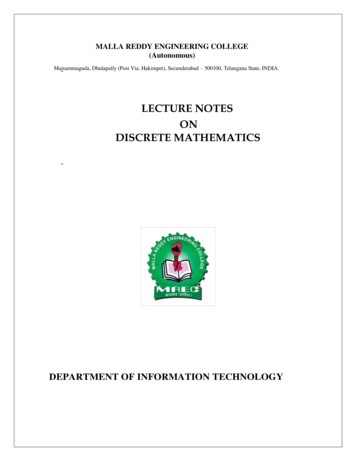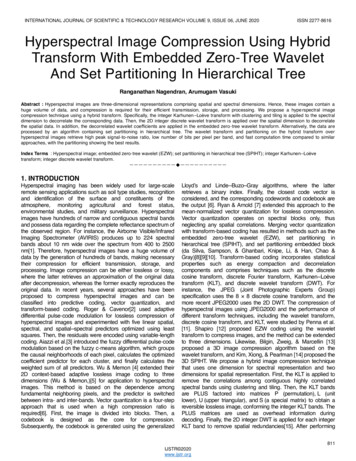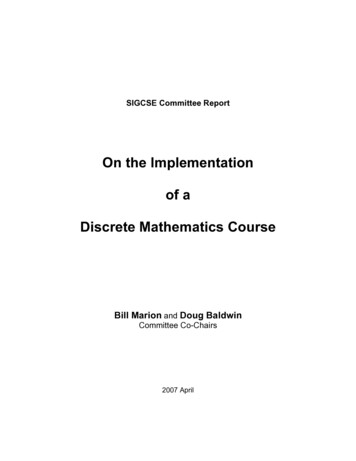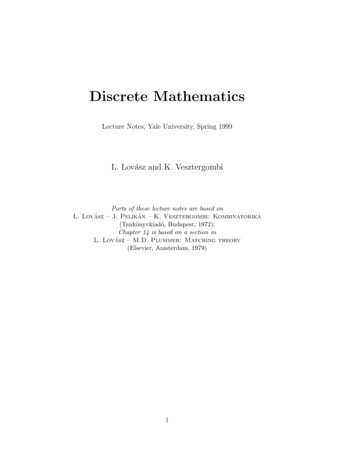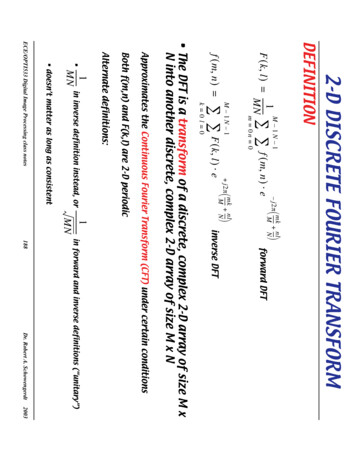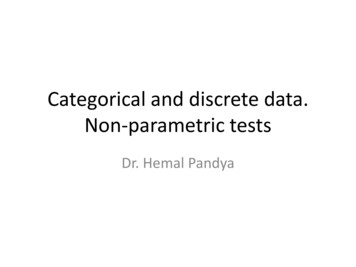
Transcription
Categorical and discrete data.Non-parametric testsDr. Hemal Pandya
Learning Objectives Develop the need for inferential techniquesthat require fewer, or less stringent,assumptions than the methods of earlierchaptersIntroduce nonparametric tests that are basedon ranks (i.e., on an ordering of the samplemeasurements according to their relativemagnitudes)
Non-parametric tests:estimate sample differences when the knowndistribution shapes cannot help, or evenconfuse
Parametric Vs Non-parametric TestsParametric Tests: The population mean (μ), standard deviation(s) and proportion (p) are called theparameters of a distribution. Tests of hypotheses concerning the mean andproportion are based on the assumption thatthe population(s) from where the sample isdrawn is normally distributed. Tests based on the above parameters arecalled parametric tests.
Parametric Vs. Non-parametricTestsNon-Parametric Tests: There are situations where the populations under study are notnormally distributed. The data collected from these populationsis extremely skewed. Therefore, the parametric tests are notvalid. The option is to use a non-parametric test. These tests arecalled the distribution-free tests as they do not require anyassumption regarding the shape of the population distributionfrom where the sample is drawn. These tests could also be used for the small sample sizes wherethe normality assumption does not hold true.
Advantages of Non-ParametricTests They can be applied to many situations as they do not have therigid requirements of their parametric counterparts, like thesample having been drawn from the population following anormal distribution. There can be applications where a numeric observation isdifficult to obtain but a rank value is not. By using ranks, it ispossible to relax the assumptions regarding the underlyingpopulations. Non-parametric tests can often be applied to the nominal andordinal data that lack exact or comparable numerical values. Non-parametric tests involve very simplecomputationscompared to the corresponding parametric tests.
Disadvantages of Non-ParametricTests A lot of information is wasted because the exactnumerical data is reduced to a qualitative form. Theincrease or the gain is denoted by a plus sign whereas adecrease or loss is denoted by a negative sign. Noconsideration is given to the quantity of the gain or loss. Non-parametric methods are less powerful thanparametric tests when the basic assumptions ofparametric tests are valid. Null hypothesis in a non-parametric test is looselydefined as compared to the parametric tests. Therefore,whenever the null hypothesis is rejected, a nonparametric test yields a less precise conclusion ascompared to the parametric test.
SLIDE 14-5Difference between Parametric &Non-parametric Tests
Nonnormal Distributions t-Statistic is Invalid
Distribution-Free TestsDistribution-free tests are statistical tests that donot rely on any underlying assumptions about theprobability distribution of the sampled population.The branch of inferential statistics devoted todistribution-free tests is called nonparametrics.Nonparametric statistics (or tests) based on theranks of measurements are called rank statistics(or rank tests). 2011 Pearson Education, Inc
Parametric and nonparametric tests ofsignificanceOne groupTwounrelatedgroupsNonparametric testsParametric testsNominaldataChi squaregoodnessof fitChi squareOrdinal, interval,ratio dataOne group t-testOrdinal dataWilcoxonsigned rank testWilcoxon ranksum test,Mann-WhitneytestTwo related McNemar’s Wilcoxongroupstestsigned rank testK-unrelated Chi square Kruskal -Wallisgroupstestone wayanalysis dent’s t-testPaired Student’st-testANOVAANOVA withrepeatedmeasurements
14 Nonparametric Methods and ChiSquare Tests (1)Using StatisticsThe Sign TestThe Runs Test - A Test for RandomnessThe Mann-Whitney U TestThe Wilcoxon Signed-Rank TestThe Kruskal-Wallis Test - A NonparametricAlternative to One-Way ANOVA
14 Nonparametric Methods and ChiSquare Tests (2)The Friedman Test for a Randomized BlockDesignThe Spearman Rank Correlation CoefficientA Chi-Square Test for Goodness of FitContingency Table Analysis - A Chi-Square Testfor IndependenceA Chi-Square Test for Equality of Proportions
14 LEARNING OBJECTIVESAfter reading this chapter you should be able to: Differentiate between parametric andnonparametric tests Conduct a sign test to compare population means Conduct a runs test to detect abnormal sequences Conduct a Mann-Whitney test for comparingpopulation distributions Conduct a Wilkinson’s test for paired differences
14 LEARNING OBJECTIVES (2)After reading this chapter you should be able to: Conduct a Friedman’s test for randomized block designsCompute Spearman’s Rank CorrelationCoefficient for ordinal dataConduct a chi-square test for goodness-offitConduct a chi-square test for independenceConduct a chi-square test for equality ofproportions
14-1 Using Statistics (ParametricTests) Parametric Methods Inferences based on assumptions about thenature of the population distribution Usually: population is normal Types of tests z-test or t-test» Comparing two population means or proportions» Testing value of population mean or proportionANOVA» Testing equality of several population means
Nonparametric Tests Nonparametric Tests Distribution-free methods making noassumptions about the population distribution Types of tests Sign tests» Sign Test: Comparing paired observations» McNemar Test: Comparing qualitative variables» Cox and Stuart Test: Detecting trend Runs tests» Runs Test: Detecting randomness» Wald-Wolfowitz Test: Comparing two distributions
Nonparametric Tests (Continued) Nonparametric Tests Ranks tests Mann-Whitney U Test: Comparing two populations Wilcoxon Signed-Rank Test: Paired comparisons Comparing several populations: ANOVA with ranks» Kruskal-Wallis Test» Friedman Test: Repeated measures Spearman Rank Correlation Coefficient Chi-Square Tests Goodness of Fit Testing for independence: Contingency Table Analysis Equality of Proportions
Nonparametric Tests (Continued) Deal with enumerative (frequency counts) data.Do not deal with specific populationparameters, such as the mean or standarddeviation.Do not require assumptions about specificpopulation distributions (in particular, thenormality assumption).
Key IdeasDistribution-Free TestsDo not rely on assumptions about theprobability distribution of the sampledpopulation 2011 Pearson Education, Inc
Key IdeasNonparametricsDistribution-free tests that are based on rankstatisticsOne-sample nonparametric test for thepopulation median – sign testNonparametric test for two independent samples– Wilcoxon rank sum testNonparametric test for matched pairs –Wilcoxon signed rank test 2011 Pearson Education, Inc
Key IdeasNonparametricsNonparametric test for a completely randomizeddesign – Kruskal-Wallis testNonparametric test for a randomized blockdesign – Friedman testNonparametric test for rank correlation –Spearman’s test
Nonparametric Methods Most of the statistical methods referred to asparametric require the use of interval- orratio-scaled data. Nonparametric methods are often the onlyway to analyze nominal or ordinal data anddraw statistical conclusions. Nonparametric methods require noassumptions about the populationprobability distributions. Nonparametric methods are often calleddistribution-free methods.
Nonparametric Methods In general, for a statistical method to beclassified as nonparametric, it must satisfy atleast one of the following conditions.–––The method can be used with nominal data.The method can be used with ordinal data.The method can be used with interval or ratio datawhen no assumption can be made about thepopulation probability distribution.
Advantages ofNonparametric Tests Used with all scales Easier to compute— Developed originally before widecomputer use Make fewer assumptions Need not involve populationparameters Results may be as exact asparametric procedures 1984-1994 T/Maker Co.
Disadvantages ofNonparametric Tests May waste information— If data permit using parametricprocedures— Example: converting data fromratio to ordinal scale Difficult to compute by hand forlarge samples Tables not widely available 1984-1994 T/Maker Co.
Non-parametric Pros and Cons Advantages of non-parametric tests– Shape of the underlying distribution is irrelevant - does nothave to be normal– Large outliers have no effect– Can be used with data of ordinal quality Disadvantages– Less Power - less likely to reject H0– Reduced analytical sophistication. With nonparametric teststhere are not as many options available for analysing yourdata– Inappropriate to use with lots of tied ranks
Frequently UsedNonparametric Tests Sign Test Wilcoxon Rank Sum Test Wilcoxon Signed Rank Test Kruskal Wallis H-Test Spearman’s Rank CorrelationCoefficient 2011 Pearson Education, Inc
Single Population Inferences
Sign Test A common application of the sign test involvesusing a sample of n potential customers toidentify a preference for one of two brands of aproduct. The objective is to determine whether there is adifference in preference between the two itemsbeing compared. To record the preference data, we use a plus signif the individual prefers one brand and a minussign if the individual prefers the other brand. Because the data are recorded as plus and minussigns, this test is called the sign test.
Sign Test Tests one population median, (eta)Corresponds to t-test for one meanAssumes population is continuousSmall sample test statistic: Number of samplevalues above (or below) median— Alternative hypothesis determines Can use normal approximation if n 30
One-Sample Sign Test The test on mean discussed in Chapter 12 isbased upon the assumption that the samples aredrawn from a population having roughly theshape of a normal distribution. This assumption gets violated, especially whileusing the non-metric data (ordinal or nominal). In such situations, the standard tests can bereplaced by a non-parametric test. One such test is called one-sample sign test.
One-Sample Sign Test Suppose the interest is in testing the nullhypothesis H0 : μ μ0 against a suitablealternative hypothesis. Let n denote the size of sample for anyproblem. To conduct a sign test, each sampleobservation greater than μ0 is replaced by aplus sign, whereas each value less than μ0 isreplaced by a minus sign. In case a sample observation equals μ0, it isomitted and the size of the sample gets reducedaccordingly.
One Sample Sign Test Testing the given null hypothesis is equivalent to testing that these plusand minus signs are the values of a random variable having a binomialdistribution with p ½. For a large sample, z test as given below isused:As the binomial distribution is a discrete one whereas the normaldistribution is a continuous distribution, a correction for continuity is tobe made. For this, X is decreased by 0.5 if X np and increased by 0.5if X np.
One-Sample Sign TestAs under the null hypothesis, p ½, thereforeFor a given level of significance, the absolute value of computed Z iscompared with absolute value of tabulated Z to accept or reject the nullhypothesis.
Two-Sample Sign Test This test is a non-parametric version of paired-sample t-test. It is based upon the sign of a pair of observations. Suppose a sample of respondents is selected and their views on the image of acompany are sought. After some time, these respondents are shown an advertisement, andthereafter, the data is again collected on the image of the company. For those respondents, where the image has improved, there is a positive andfor those where the image has declined there is a negative sign assigned andfor the one where there is no change, the corresponding observation is droppedfrom the analysis and the sample size reduced accordingly. The key concept underlying the test is that if the advertisement is not effectivein improving the image of the company, the number of positive signs shouldbe approximately equal to the number of negative signs. For small samples, a binomial distribution could be used, whereas for a largesample, the normal approximation to the binomial distribution could be used,as already explained in the one-sample sign test.
Sign Test Uses p-Valueto Make DecisionBinomial: n 8 p 31234567.0048XP-value is the probability of getting an observation at least asextreme as we got. If 7 of 8 observations ‘favor’ Ha, thenp-value p(x 7) .031 .004 .035.If .05, then reject H2011Pearson p-valueEducation, Inc .0 since
Sign Test for a PopulationMedian One-Tailed TestH0: 0Ha: 0 [or Ha: 0 ]Test statistic:S Number of sample measurements greaterthan 0 [or S number of measurements less than 0]
Sign Test for a PopulationMedian Observed significance level:p-value P(x S)where x has a binomial distribution withparameters n and p .5(Use Table II, Appendix B)Rejection region: Reject H0 if p-value .05 2011 Pearson Education, Inc
Sign Test for a PopulationMedian Two-Tailed TestH0: 0Ha: 0Test statistic:S Larger of S1 and S2, where S1 is the number ofsample measurements less than 0 and S2 is thenumber of measurements greater than 0 2011 Pearson Education, Inc
Sign Test for a PopulationMedian Observed significance level:p-value 2P(x S)where x has a binomial distribution withparameters n and p .5(Use Table II, Appendix B)Rejection region: Reject H0 if p-value .05 2011 Pearson Education, Inc
Conditions Required for ValidApplication of the Sign TestThe sample is selected randomly from acontinuous probability distribution.[Note: No assumptions need to be made about theshape of the probability distribution.]
Large Sample Sign Test for aPopulation Median One-Tailed TestH0: 0Ha: 0 [or Ha: 0 ]Test statistic:S .5 .5n z .5 nS Number of sample measurements greaterthan 0 [or S number of measurements less than 0] The “– .5” is the “correction for continuity.” 2011 Pearson Education, Inc
Large Sample Sign Test for aPopulation Median The null hypothesized mean value is np .5n,and the standard deviation is npq n .5 .5 .5 nRejection region: z z where tabulated z-values can be found in TableIV of Appendix B. 2011 Pearson Education, Inc
Large Sample Sign Test for aPopulation Median Two-Tailed TestH0: 0Ha: 0Test statistic:S .5 .5n z .5 nS Larger of S1 and S2, where S1 is the number ofsample measurements less than 0 and S2 is thenumber of measurements greater than 0 2011 Pearson Education, Inc
Large Sample Sign Test for aPopulation Median The null hypothesized mean value is np .5n,and the standard deviation is npq n .5 .5 .5 nRejection region: z z where tabulated z-values can be found in TableIV of Appendix B.
Sign Test ExampleYou’re an analyst for Chef-BoyR-Dee. You’ve asked 7 peopleto rate a new ravioli on a 5point Likert scale (1 terrible to5 excellent). The ratings are:2 5 3 4 1 4 5At the .05 level of significance,is there evidence that themedian rating is less than 3? 2011 Pearson Education, Inc
Sign Test Solution H0: 3Ha: 3 .05Test Statistic:S 2(Ratings 1 & 2 areless than 3:2, 5, 3, 4, 1, 4, 5)p-value:P(x 2) 1 – P(x 1) .937(Binomial Table, n 7,p 0.50)Decision:Do not reject at .05Conclusion:There is no evidencemedian is less than 3 2011 Pearson Education, Inc
Sign Test Comparing paired observations Paired observations: X and Y p P(X Y) Two-tailed test Right-tailed test Left-tailed test Test statistic:H0: p 0.50H1: p 0.50H0: p 0.50H1: p 0.50H0: p 0.50H1: p 0.50T Number of signs
Sign Test Decision Rule Small Sample: Binomial Test For a two-tailed test, find a critical point correspondingas closely as possible to /2 (C1) and define C2 as n-C1.Reject null hypothesis if T C1or T C2. For a right-tailed test, reject H0 if T C, where C is thevalue of the binomial distribution with parameters nand p 0.50 such that the sum of the probabilities of allvalues less than or equal to C is as close as possible tothe chosen level of significance, . For a left-tailed test, reject H0 if T C, where C isdefined as above.
Sign Test Comparing paired observations Paired observations: X and Y p P(X Y) Two-tailed test Right-tailed test Left-tailed test Test statistic:H0: p 0.50H1: p 0.50H0: p 0.50H1: p 0.50H0: p 0.50H1: p 0.50T Number of signs
Sign Test Decision Rule Small Sample: Binomial Test For a two-tailed test, find a critical point correspondingas closely as possible to /2 (C1) and define C2 as n-C1.Reject null hypothesis if T C1or T C2. For a right-tailed test, reject H0 if T C, where C is thevalue of the binomial distribution with parameters nand p 0.50 such that the sum of the probabilities of allvalues less than or equal to C is as close as possible tothe chosen level of significance, . For a left-tailed test, reject H0 if T C, where C isdefined as above.
ExampleCEO Before 23151216321745Sign1011011-11-111111-11 n 15T 12 0.025C1 3 C2 15-3 12H0 rejected, sinceT C2C1CumulativeBinomialProbabilities(n 15, p 0.98242120.99631130.99951140.99997151.00000
Example 14-1- Using the TemplateH0: p 0.5H1: p 0.5Test Statistic: T 12p-value 0.0352.For 0.05, the null hypothesisis rejected since 0.0352 0.05.Thus one can conclude that thereis a change in attitude toward aCEO following the award of anMBA degree.
Run Test for RandomnessRun test is used to test the randomness of a sample.Run: A run is defined as a sequence of like elements that are precededand followed by different elements or no elements at all.Letn Total size of the samplen1 Size of sample in group 1n2 Size of sample in group 2r Number of runsFor large samples, either n1 20 or n2 20, the distribution of runs (r) isnormally distributed with:MeanStandardDeviation
Run Test for RandomnessThe hypothesis is to be tested is:H0 : The pattern of sequence is random.H1 : The pattern of sequence is not random.For a large sample the test statistic is given by:For a given level of significance, if the absolute value of computed z isgreater than the absolute value of tabulated z, null hypothesis isrejected.In case of numerical data, the original data are grouped into twocategories, one above and second below median.
14-3 The Runs Test - A Test forRandomnessA run is a sequence of like elements that are preceded and followedby different elements or no element at all.Case 1: S E S E S E S E S E S E S E S E S E S ECase 2: SSSSSSSSSS EEEEEEEEEECase 3: S EE SS EEE S E SS E S EE SSS E: R 20 Apparently nonrandom: R 2 Apparently nonrandom: R 12 Perhaps randomA two-tailed hypothesis test for randomness:H0: Observations are generated randomlyH1: Observations are not generated randomlyTest Statistic:R Number of RunsReject H0 at level if R C1 or R C2, as given in Table 8, with total tailprobability P(R C1) P(R C2) .
Runs Test: ExamplesTable 8:(n1,n2)11(10,10)0.586 0.758 0.872 0.949 0.981 0.996 0.999 1.000 1.000 1.000.12Number of Runs (r)13 14 15 16 1718Case 1: n1 10 n2 10 R 20 p-value 0Case 2: n1 10 n2 10 R 2 p-value 0Case 3: n1 10 n2 10 R 12p-value P R F(11)] (2)(1-0.586) (2)(0.414) 0.828H0 not rejected1920
Large-Sample Runs Test: Using theNormal ApproximationThe mean of the normal distribution of the number of runs:E ( R) 2n n 1n n1212The standard deviation: R2n n ( 2n n n n )( n n ) ( n n 1)12121221212The standard normal test statistic:z R E ( R) R
Large-Sample Runs Test: Example14-2Example 14-2: n1 27 n2 26 R 152n n( 2)(27 )(26)E ( R) 1 2 1 1 26.49 1 27.49n n( 27 26)1 22n n ( 2n n n n )1 2 1 2 1 2 ( 2)(27 )(26)((2)(27 )(26) 27 26)) R( n n ) 2 ( n n 1)( 27 26) 2 ( 27 26 1)1 21 21896804 12.986 3.604146068R E ( R ) 15 27.49z 3.47 3.604Rp - value 2(1 - .9997) 0.0006H0 should be rejected at any common level of significance.
Large-Sample Runs Test: Example14-2 – Using the TemplateNote:The computedp-value using thetemplate is 0.0005as compared tothe manuallycomputed value of0.0006. The valueof 0.0005 is moreaccurate.Reject the nullhypothesis thatthe residuals arerandom.
Using the Runs Test to Compare Two PopulationDistributions (Means): the Wald-Wolfowitz TestThe null and alternative hypotheses for the Wald-Wolfowitz test:H0: The two populations have the same distributionH1: The two populations have different distributionsThe test statistic:R Number of Runs in the sequence of samples, whenthe data from both samples have been sorted
The Wald-Wolfowitz Test: AAAAAAARunsn1 10 n2 9 R 4p-value P R 0.00 H0 may be rejected12Table(n1,n2)3.Number of Runs (r)2345(9,10) 0.000 0.000 0.002 0.004 .4
Ranks Tests Ranks tests Mann-Whitney U Test: Comparing twopopulations Wilcoxon Signed-Rank Test: Pairedcomparisons Comparing several populations: ANOVA withranks Kruskal-Wallis Test Friedman Test: Repeated measures
Mann-Whitney U Test forIndependent Samples This test is an alternative to a t test fortesting the equality of means of twoindependent samples The application of a t test involves theassumption that the samples are drawn fromthe normal population. If the normality assumption is violated, thistest can be used as an alternative to a t test.
Mann-Whitney U Test forIndependent Samples A two-tailed hypothesis for a Mann-Whitney test could bewritten as:H0 : Two samples come from identical populationsorTwo populations have identical probability distribution.H1 : Two samples come from different populationsorTwo populations differ in locations.
Mann-Whitney U Test forIndependent SamplesThe following steps are used in conducting this test:(i) The two samples are combined (pooled) into one large sampleand then we determine the rank of each observation in thepooled sample. If two or more sample values in the pooledsamples are identical, i.e., if there are ties, the sample values areeach assigned a rank equal to the mean of the ranks that wouldotherwise be assigned.(ii) We determine the sum of the ranks of each sample. Let R1 andR2 represent the sum of the ranks of the first and the secondsample whereas n1 and n2 are the respective sample sizes of thefirst and the second sample. For convenience, choose n1 as asmall size if they are unequal so that n1 n2. A significantdifference between R1 and R2 implies a significant differencebetween the samples.
Mann-Whitney U Test forIndependent SamplesIf n1 or n2 10, a Z test would be appropriate. For this purpose, eitherof U1 or U2 could be used for testing a one-tailed or a two-tailed test.In this test, U2 will be used for the purpose.
Mann-Whitney U Test forIndependent SamplesUnder the assumption that the null hypothesis is true, the U2 statisticfollows an approximately normal distribution with mean: Assuming the level of significance as equal to α, if the absolute samplevalue of Z is greater than the absolute critical value of Z, i.e., Zα/2, thenull hypothesis is rejected. A similar procedure is used for a one-tailed test.
14-4 The Mann-Whitney U Test(Comparing Two Populations)The null and alternative hypotheses:H0: The distributions of two populations are identicalH1: The two population distributions are not identicalThe Mann-Whitney U statistic:n1 ( n1 1)U n1 n2 R1R 1 Ranks from sample 12where n1 is the sample size from population 1 and n2 is thesample size from population 2.n1n2n1n2 (n1 n2 1)E[U ] U 212U E[U ]The large - sample test statistic: z U
The Mann-Whitney U Test:Example ank581012116213497RankSumU n1 n 2 n1 ( n1 1)2(6)(6 1) (6)(6) 55226 R1 522Cumulative Distribution Function of the MannWhitney U Statisticn2 6n1 6u.40.0130P(u 5)50.020660.0325.
Example 14-5: Large-SampleMann-Whitney U TestScore re 5.587.5101.0106.0112.5130.5149.5152.5Since the test statistic is z -3.32,the p-value 0.0005, and H0 is rejected.U n1n2 n1 ( n1 1) R12(15)(15 1) (15)(15) 312 .5 32 .52n1n2(15)(15)E [U ] 112.522n1n2 ( n1 n2 1) U 12(15)(15)(15 15 1) 24 .10912U E [U ]32 .5 112 .5z 3.32 U24 .109
Example 14-5: Large-SampleMann-Whitney U Test – Using the TemplateSince the teststatistic is z -3.32,the p-value 0.0005,and H0 is rejected.That is, the LC(Learning Curve)program is moreeffective.
When Should I Use theMann-Whitney U Test?– Non-parametric distribution– Independent Measures– Ratio or interval data, but must be reduced toordinal data because it is non-parametric– Different variances for two groups– It assumes Random assignments to groups– Test statistic: U
Mann-Whitney U Test What is it for? A non-parametric test to compare the centraltendencies of two groups It assumes Random assignments to groups Test statistic: U
Mann-Whitney U testNull hypothesisThe two groupsHave the samemedianSampleTest statisticU1 or U2compareNull distributionU with n1, n2How unusual is this test statistic?P 0.05Reject HoP 0.05Fail to reject Ho
Null Hypothesis Involves the creation of two competing explanationsfor the data recorded.– Idea 1:These are pattern-less random data. Any observedpatterns are due to chance. This is the null hypothesis H0– Idea 2: There is a defined pattern in the data. This is thealternative hypothesis H1 Without the statement of the competing hypotheses,no meaning test can be run.
Step One Arrange all the observations into a singleranked series. That is, rank all the observationswithout regard to which sample they are in. In other words, combine all of the data fromboth groups into a single column, in order, butkeep track of what group they came from.
Mann-Whitney U Test If you have ties:– Rank them anyway, pretending they were slightlydifferent– Find the average of the ranks for the identicalvalues, and give them all that rank– Carry on as if all the whole-number ranks havebeen used up
ExampleData142542141814
2G1G1G2G1G2
2G1G1G2G1G2TIES
2G1G1G2G1G2TIESRank themanyway,pretendingthey wereslightlydifferent
2G1G1G2G1G2Rank A12345678
2G1G1G2G1G2Rank A12345678Find theaverage of theranks for theidenticalvalues, andgive them allthat rank
2G1G1G2G1G2Rank A12345678Average 1.5Average 6
2G1G1G2G1G2Rank A12345678Rank1.51.5346668
2G1G1G2G1G2Rank A12345678Rank1.51.5346668First, sort them back into the two groups,Then these can now be used for the Mann-Whitney U test
Step Two Add up the ranks for the observations whichcame from sample 1(the smaller group, fewerparticipants). Then add up the sum of ranks in sample 2(Larger group)
Step Three U is then given by:where n1 is the sample size for sample1(smaller group), and R1 is the sum of theranks in sample 1
Step Four
Step Five The smaller value of U1 and U2 is the oneused when consulting significance tables.
Compare If the smaller value of U1 or U2 is smaller thanthe critical value in the chart, then theprobability that the differences in the groups isobtained by chance is less than 0.05, and youmay reject the null hypothesis.
14-4 The Mann-Whitney U Test(Comparing Two Populations)The null and alternative hypotheses:H0: The distributions of two populations are identicalH1: The two population distributions are not identicalThe Mann-Whitney U statistic:n1 ( n1 1)U n1 n2 R1R 1 Ranks from sample 12where n1 is the sample size from population 1 and n2 is thesample size from population 2.n1n2n1n2 (n1 n2 1)E[U ] U 212U E[U ]The large - sample test statistic: z U
The Mann-Whitney U Test:Example ank581012116213497RankSumU n1 n 2 n1 ( n1 1)2(6)(6 1) (6)(6) 55226 R1 522Cumulative Distribution Function of the MannWhitney U Statisticn2 6n1 6u.40.0130P(u 5)50.020660.0325.
Example 14-5: Large-SampleMann-Whitney U TestScore re 5.587.5101.0106.0112.5130.5149.5152.5Since the test statistic is z -3.32,the p-value 0.0005, and H0 is rejected.U n
Chi square Wilcoxon rank sum test, Mann-Whitney test 6WXGHQW¶VW WHVW Two related groups 0F1HPDU¶V test Wilcoxon signed rank test 3DLUHG6WXGHQW¶V t-test K-unrelated groups Chi square test Kruskal -Wallis one way analysis of variance ANOVA K-related groups Friedman matched samples ANOVA with repeated
